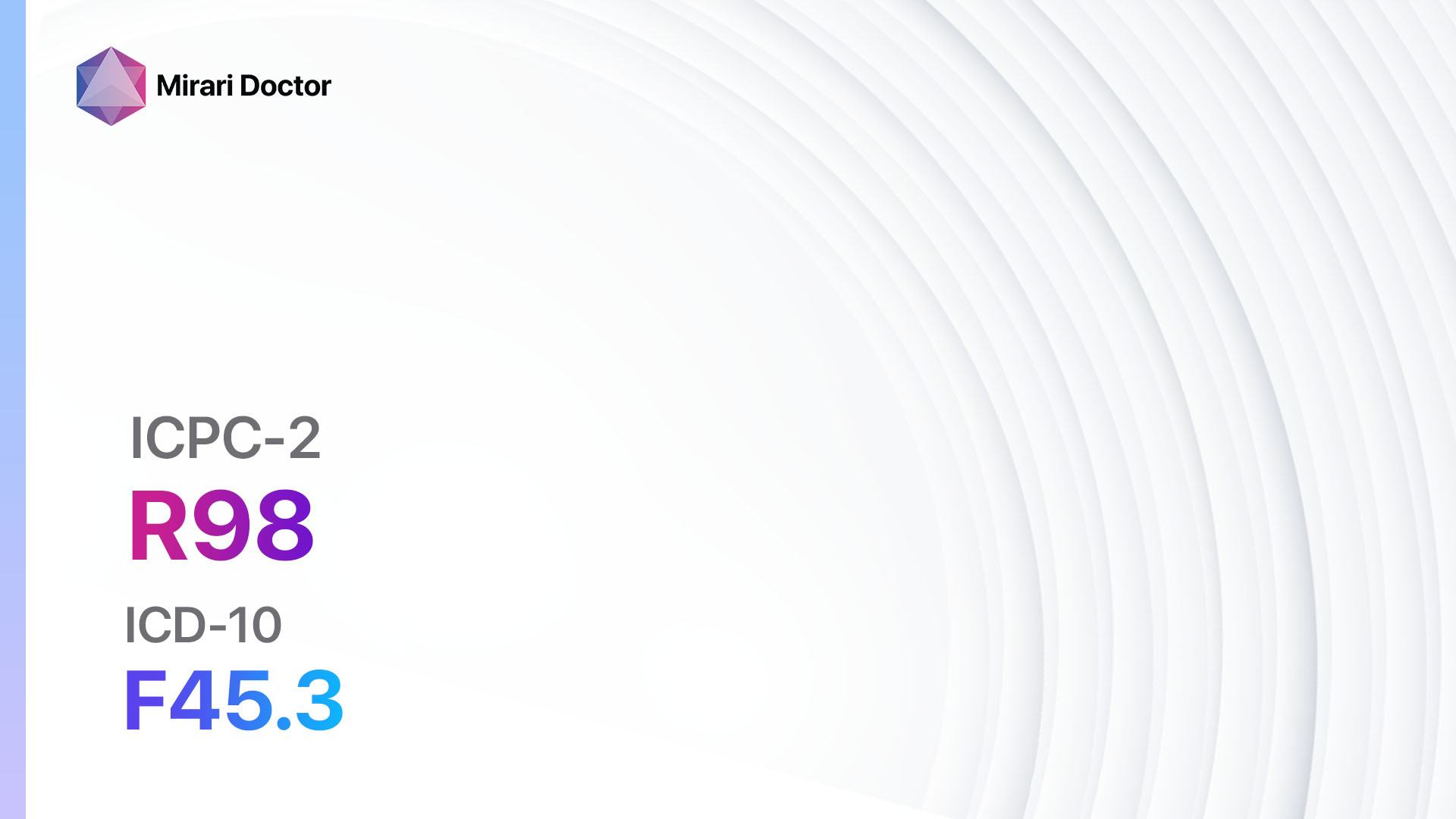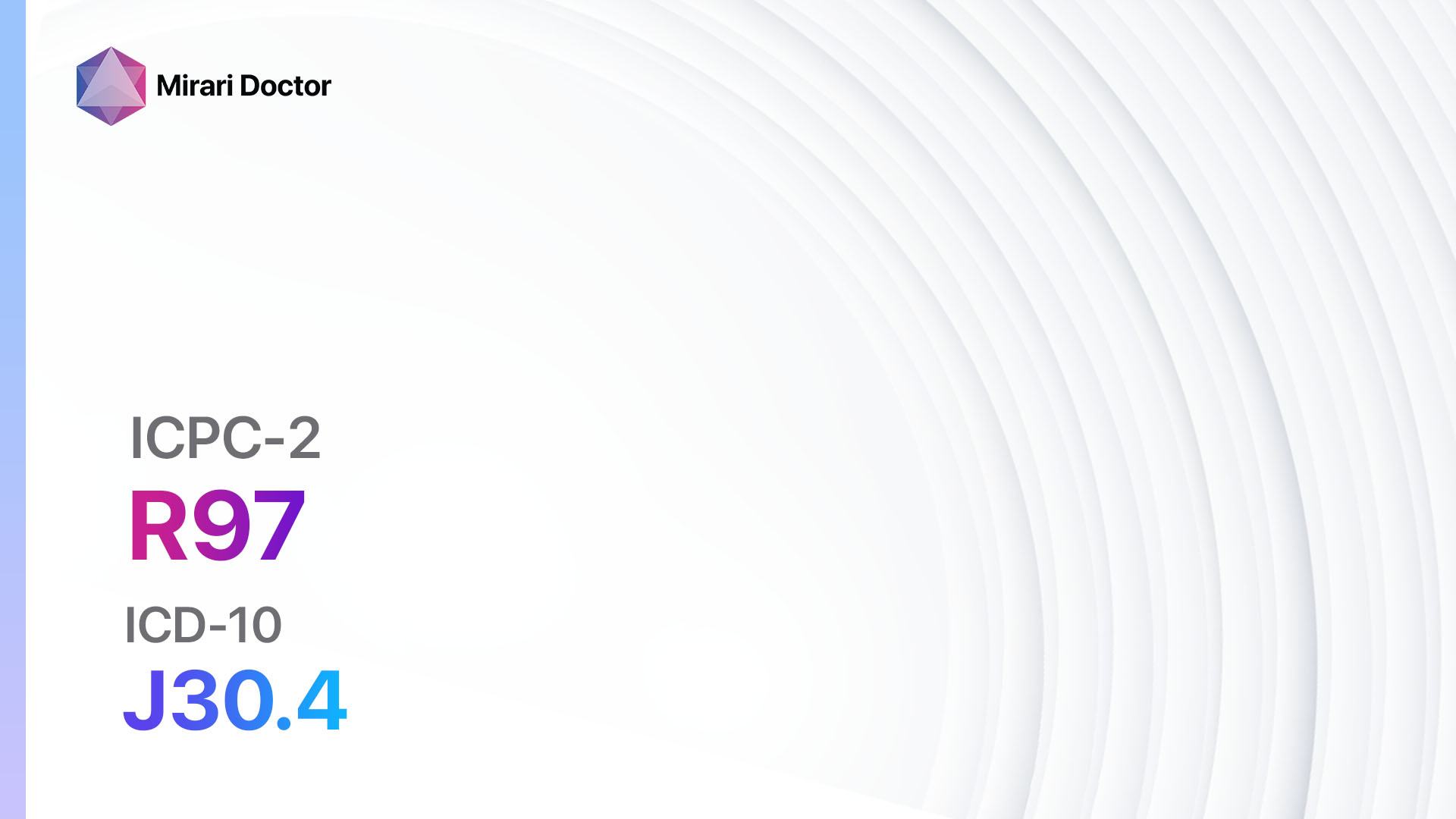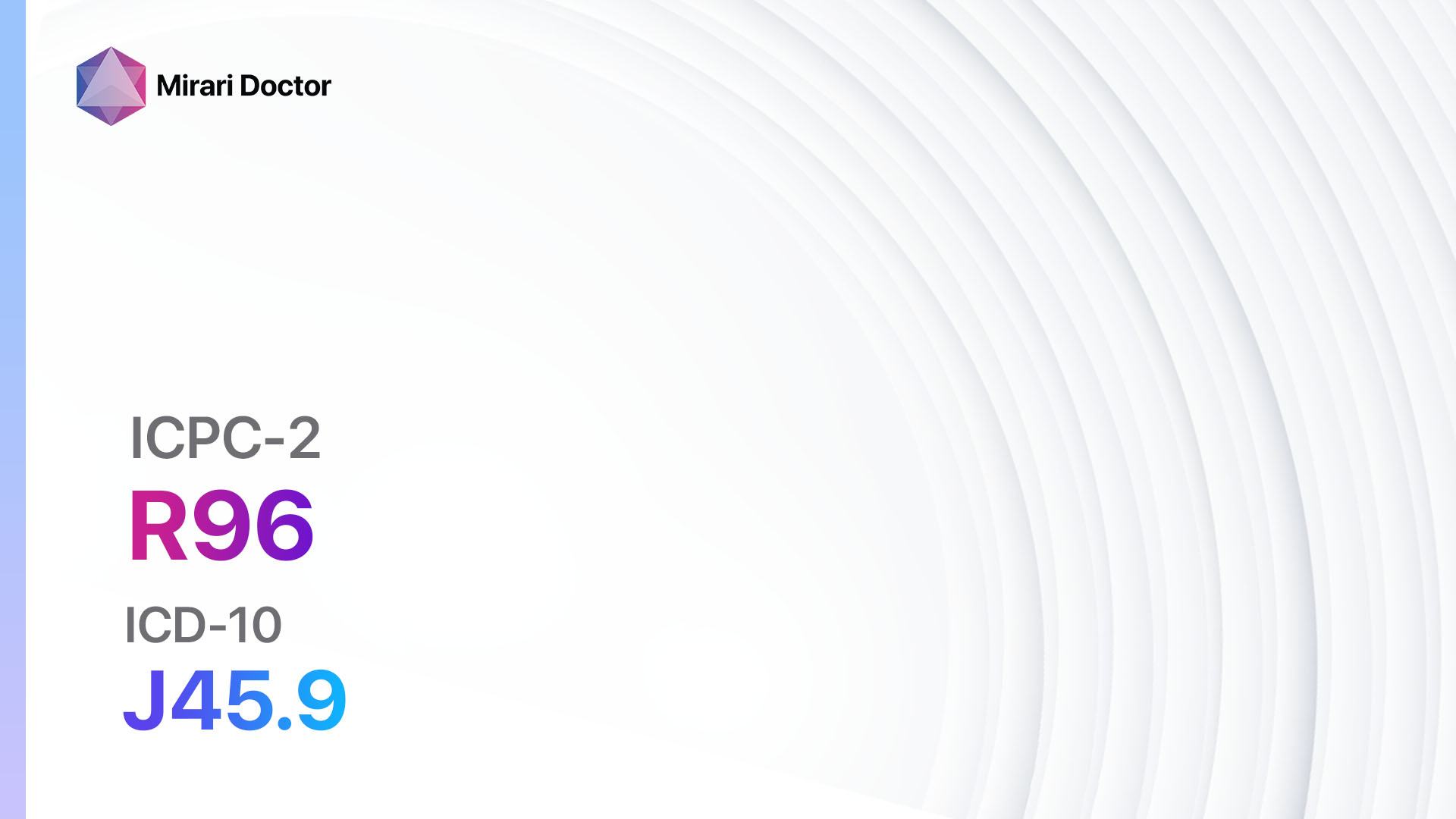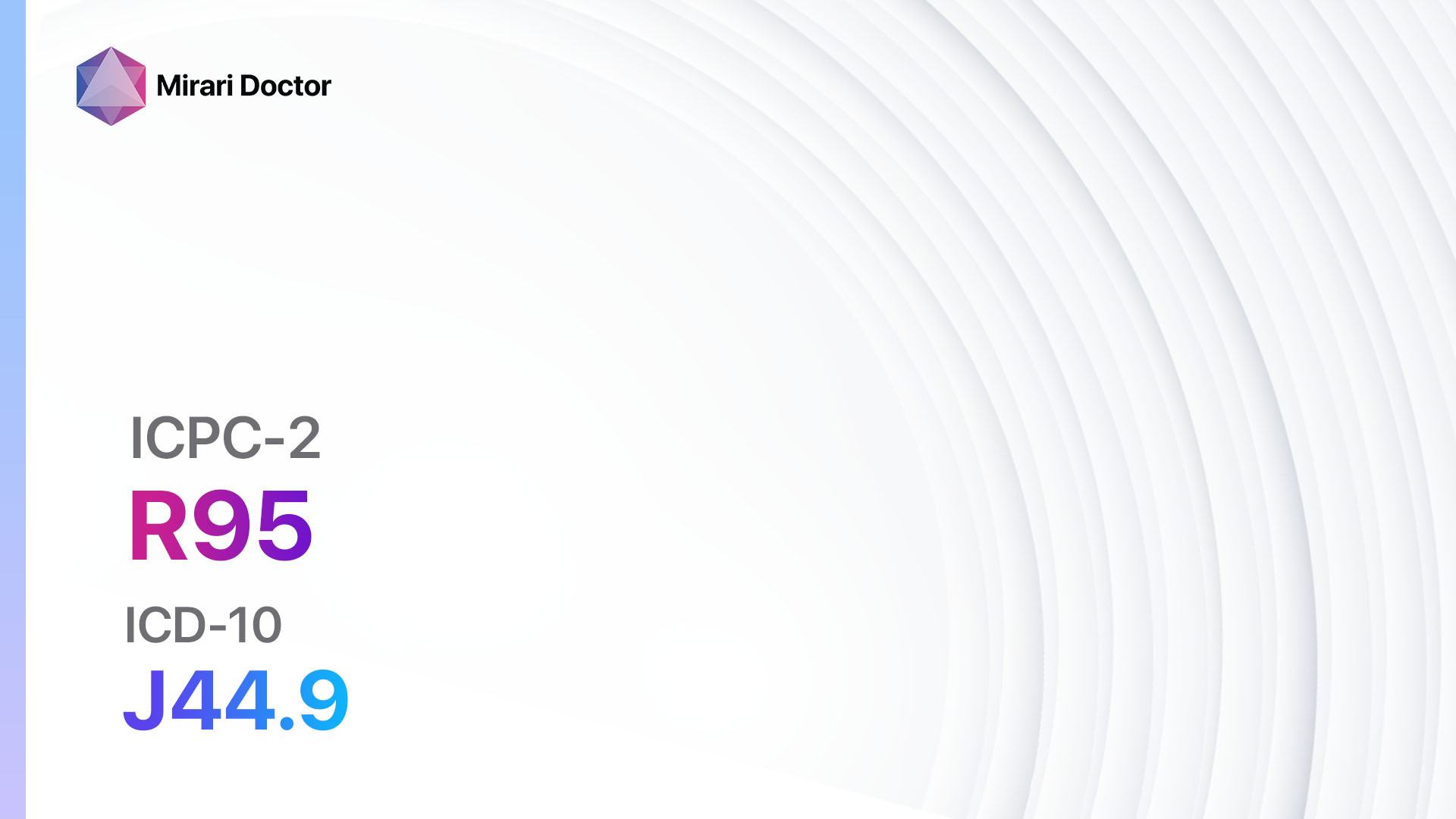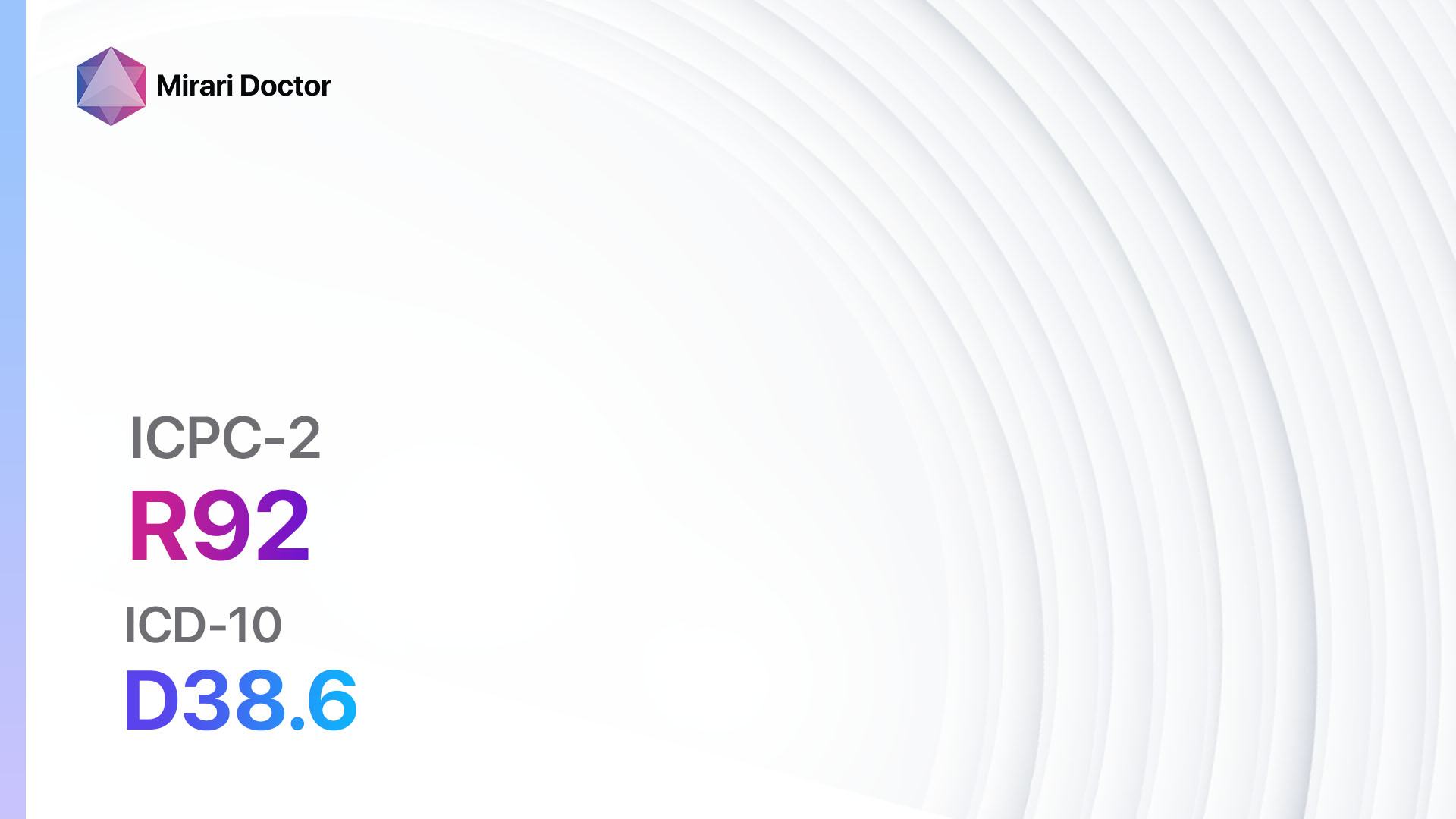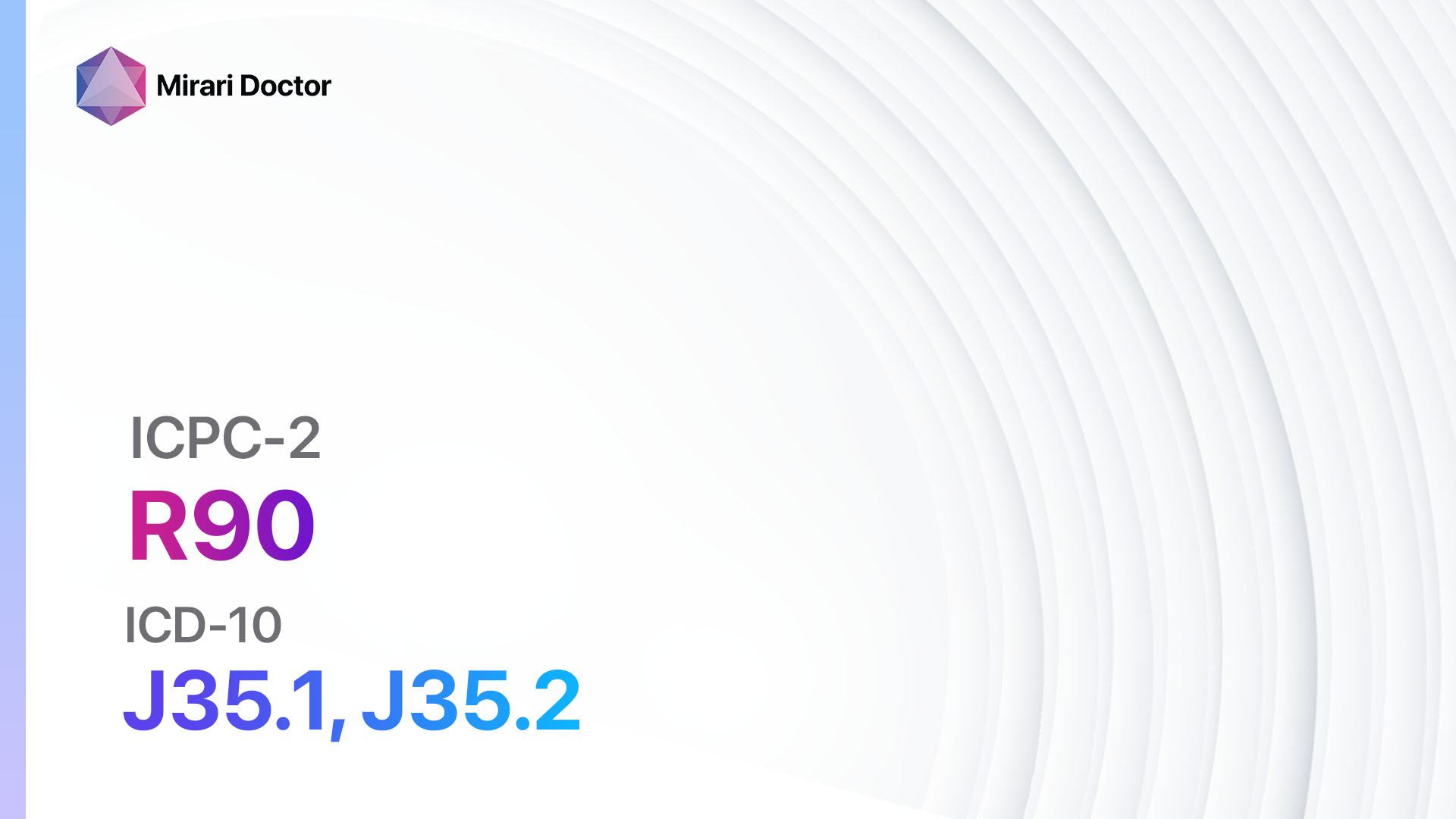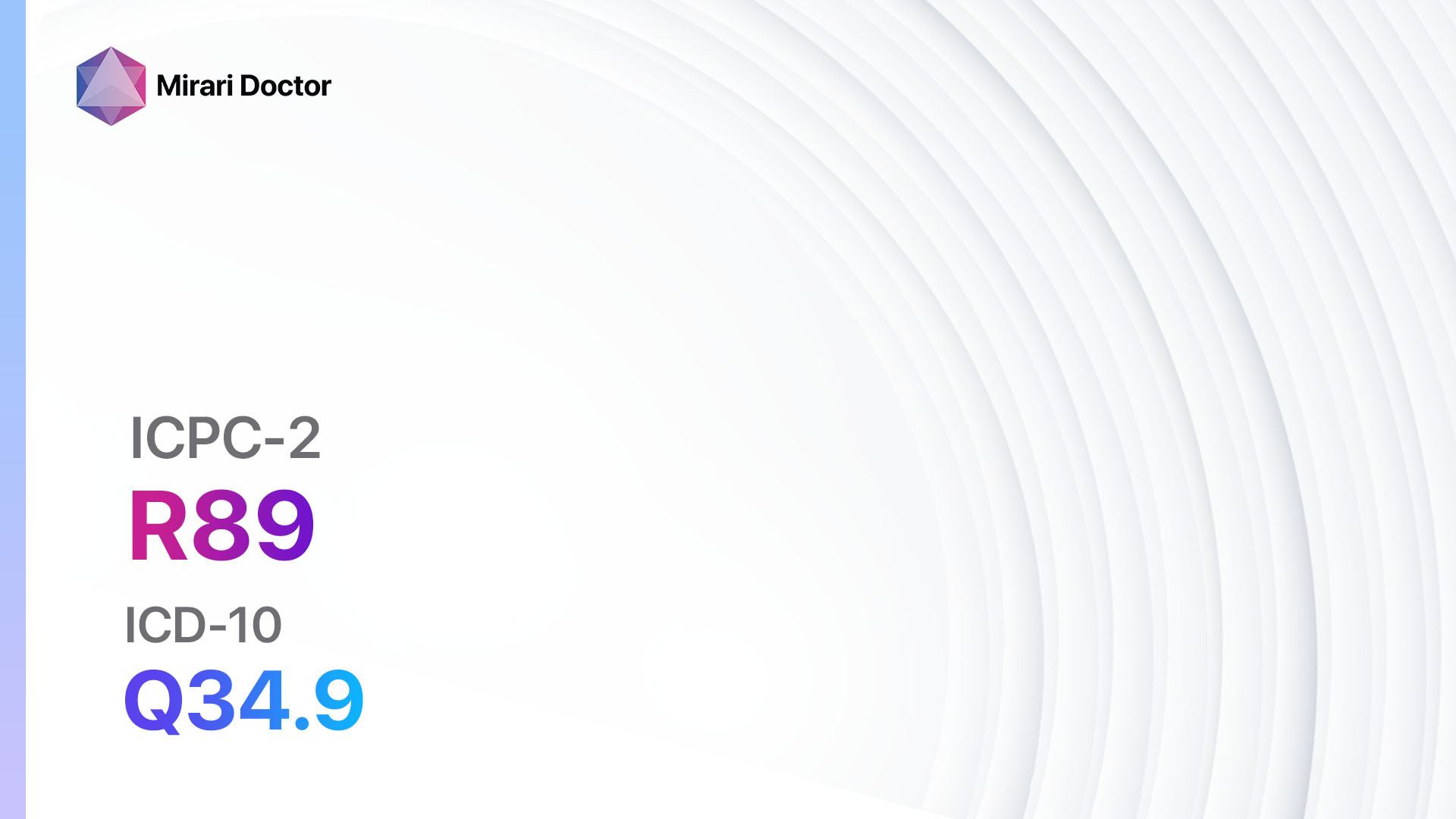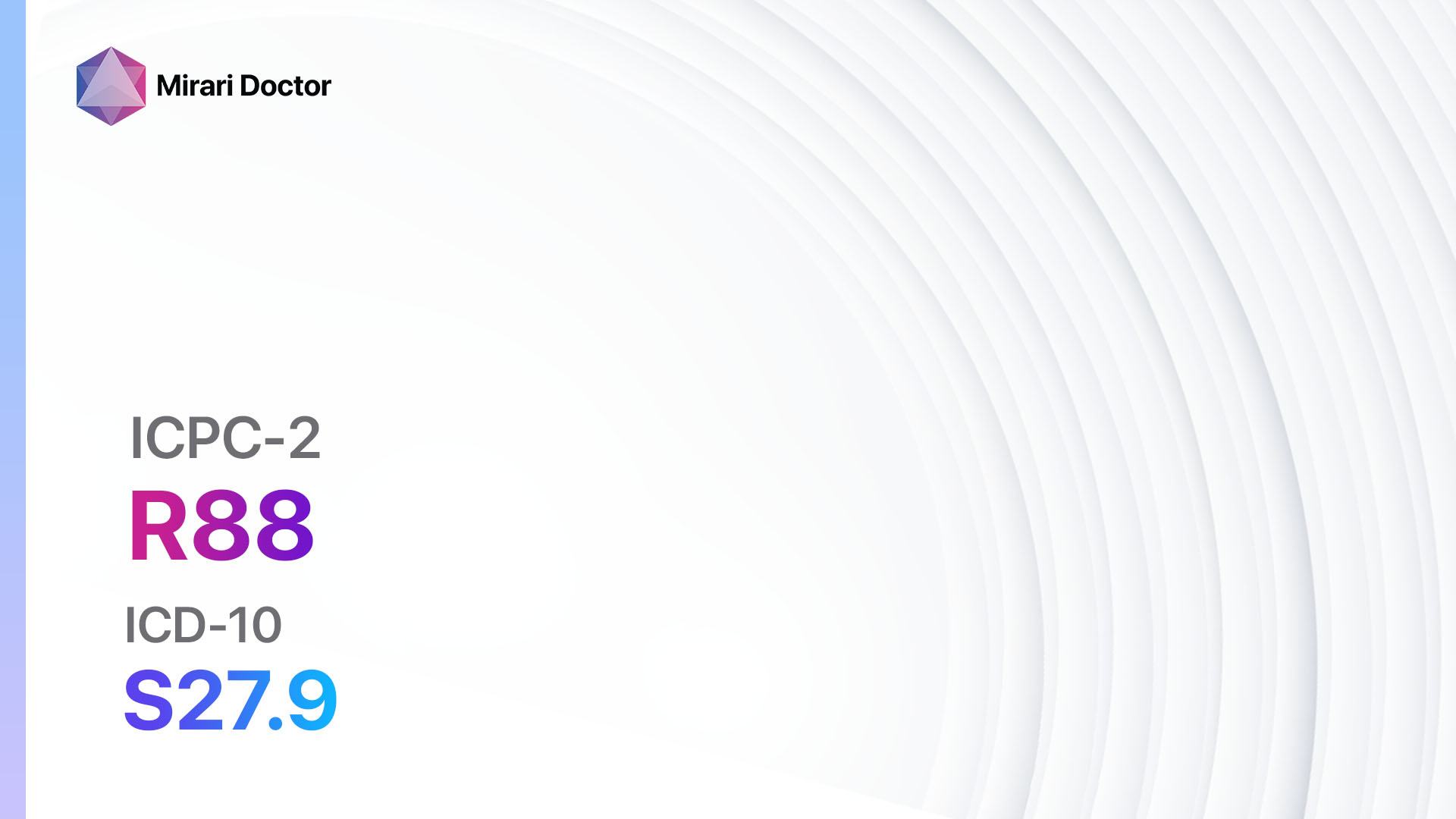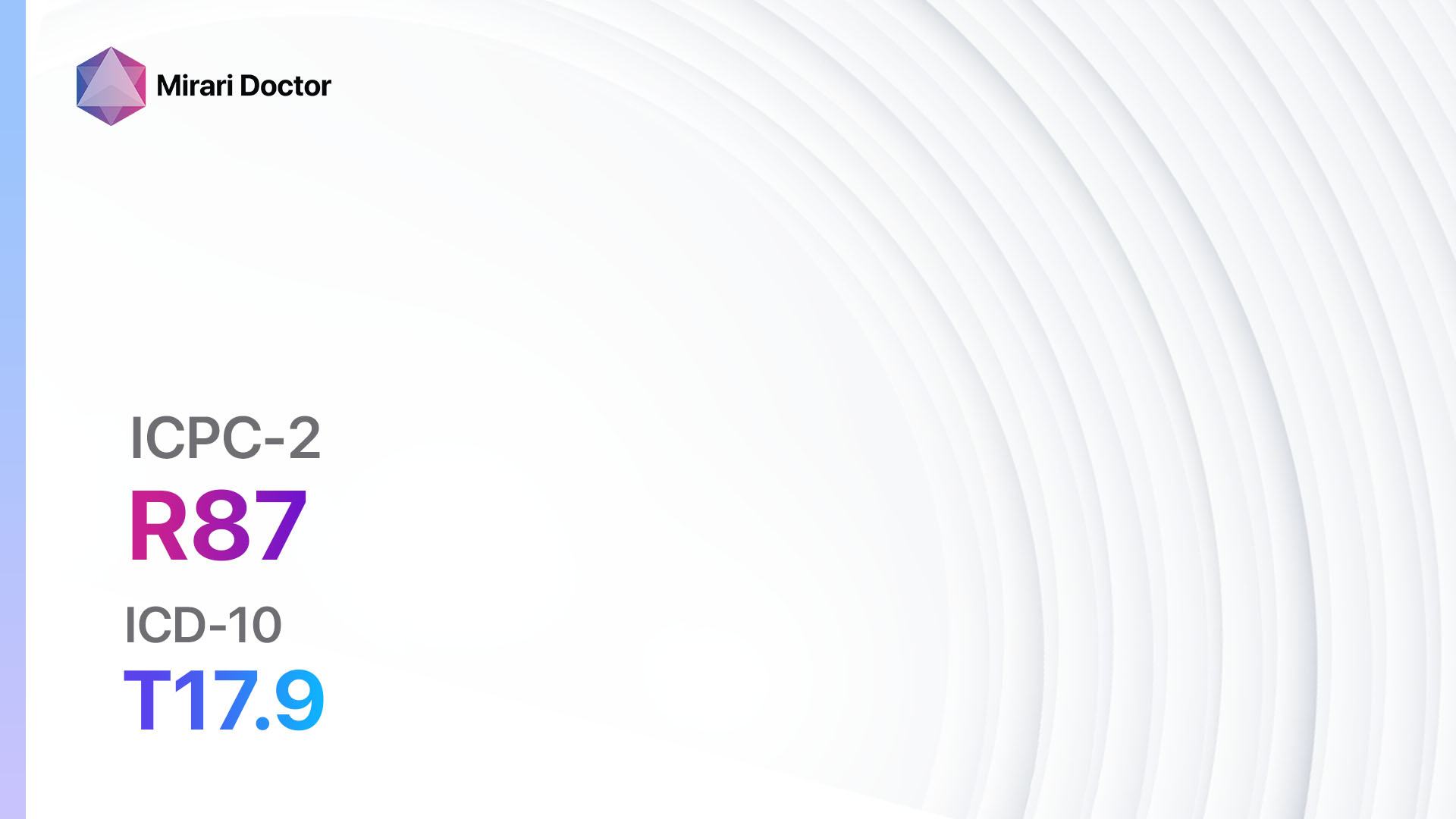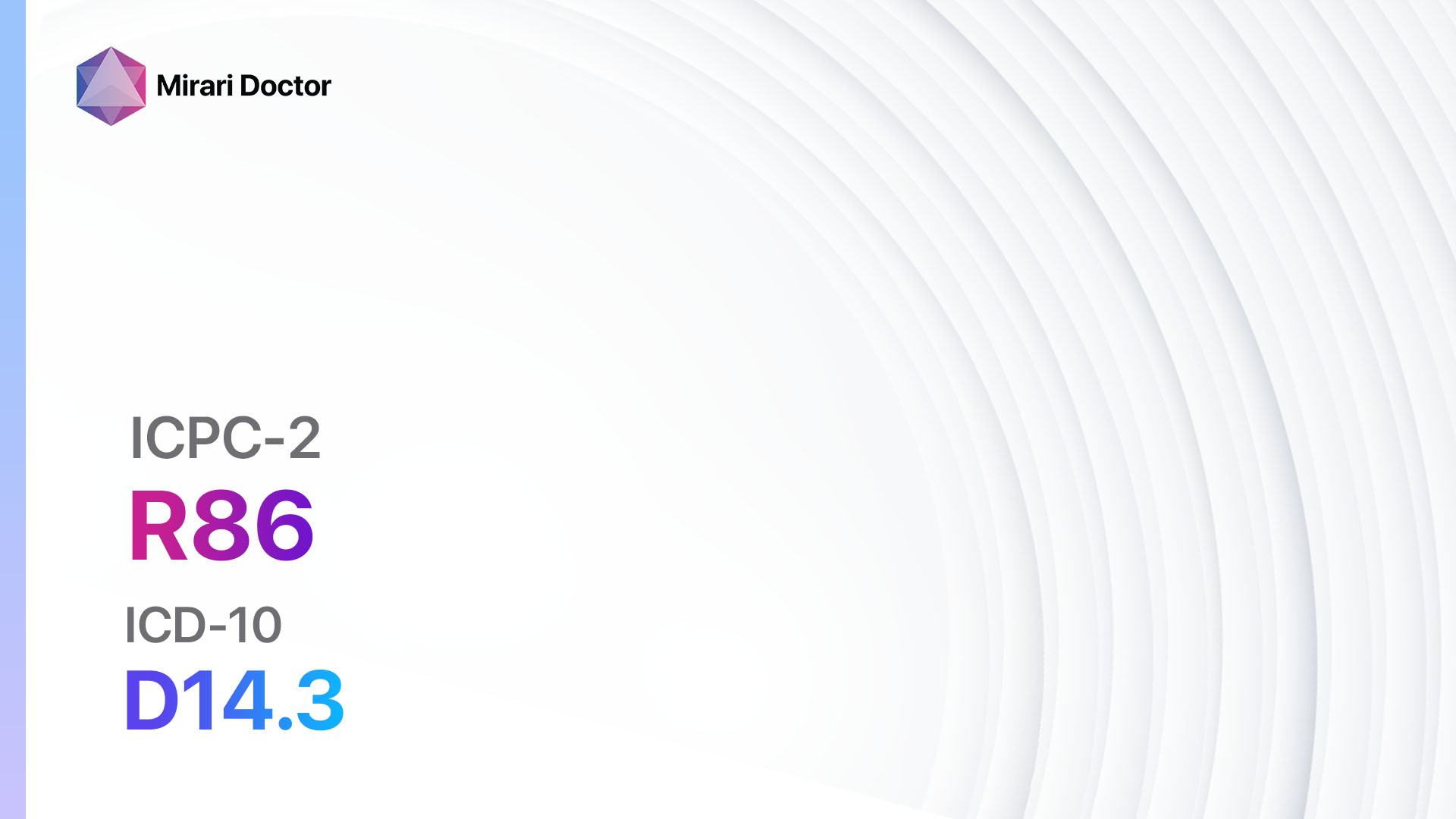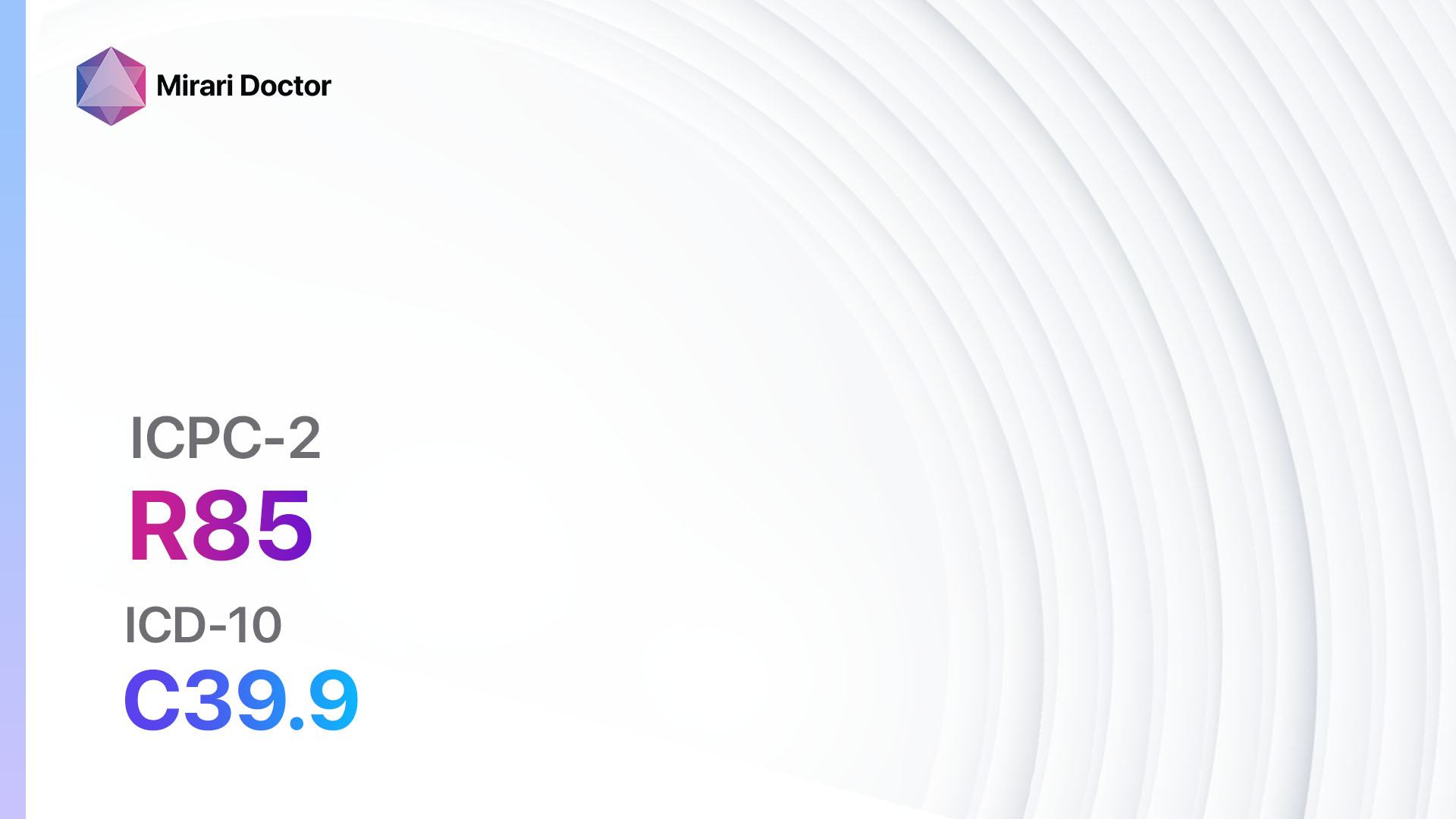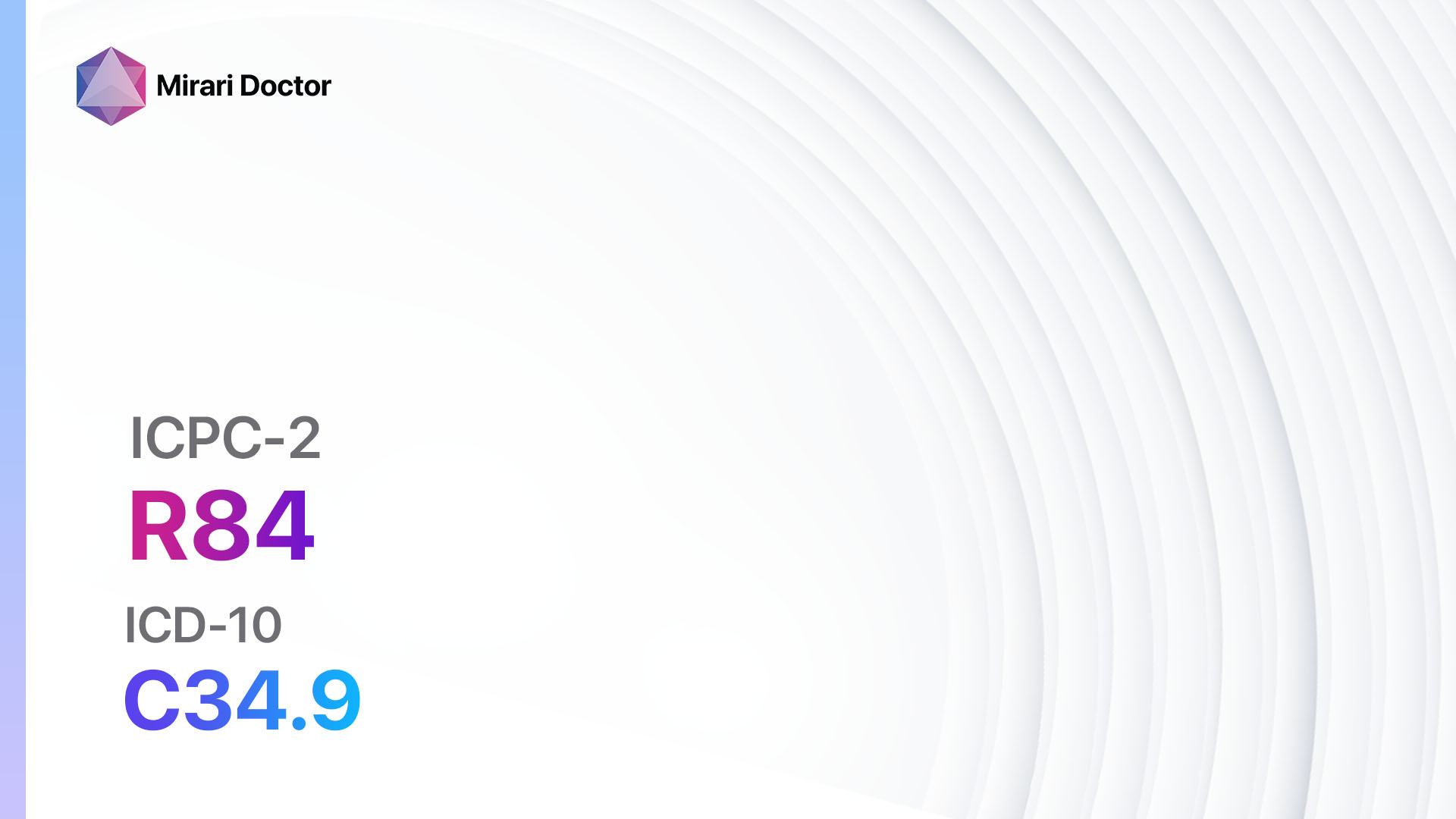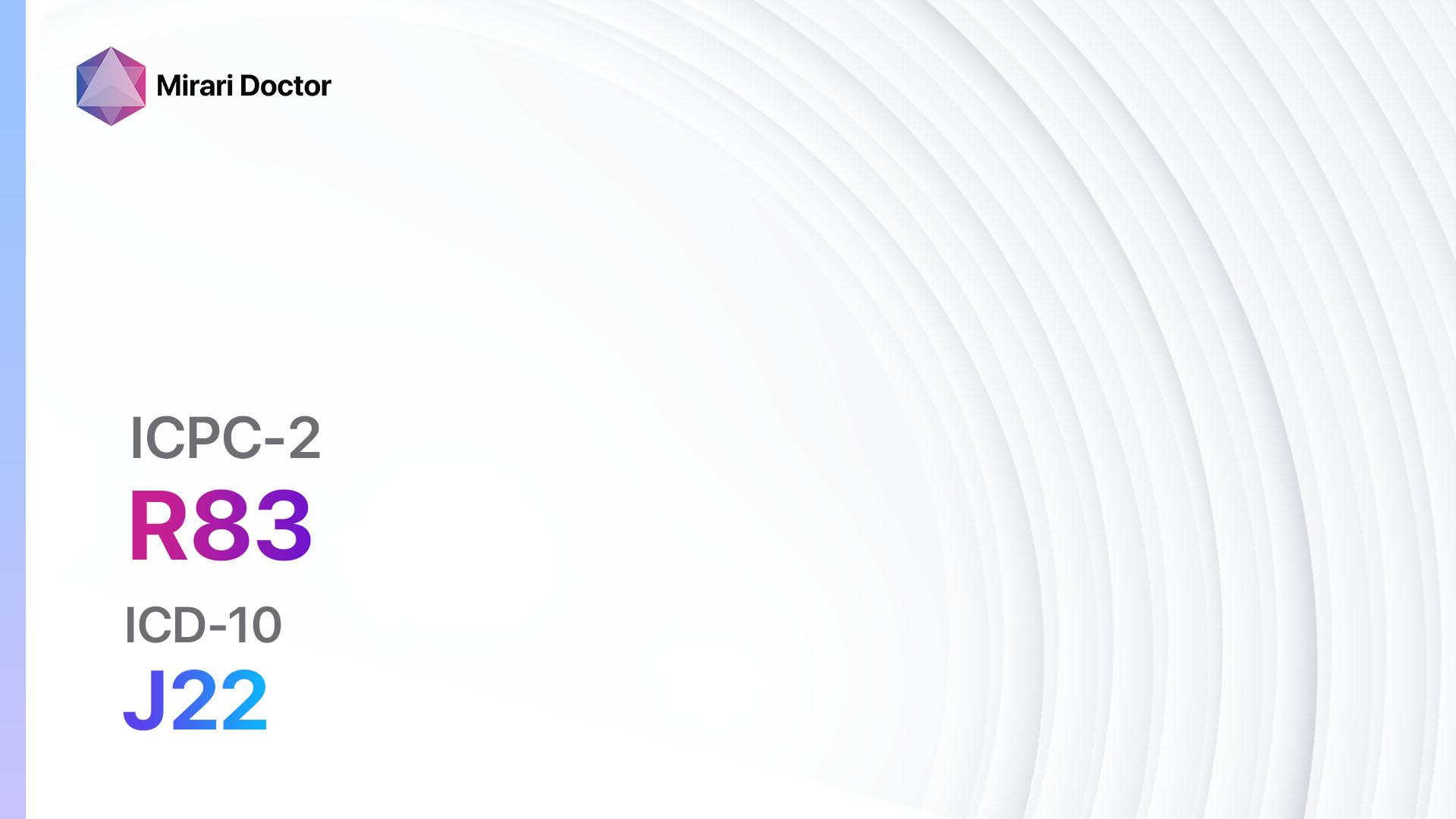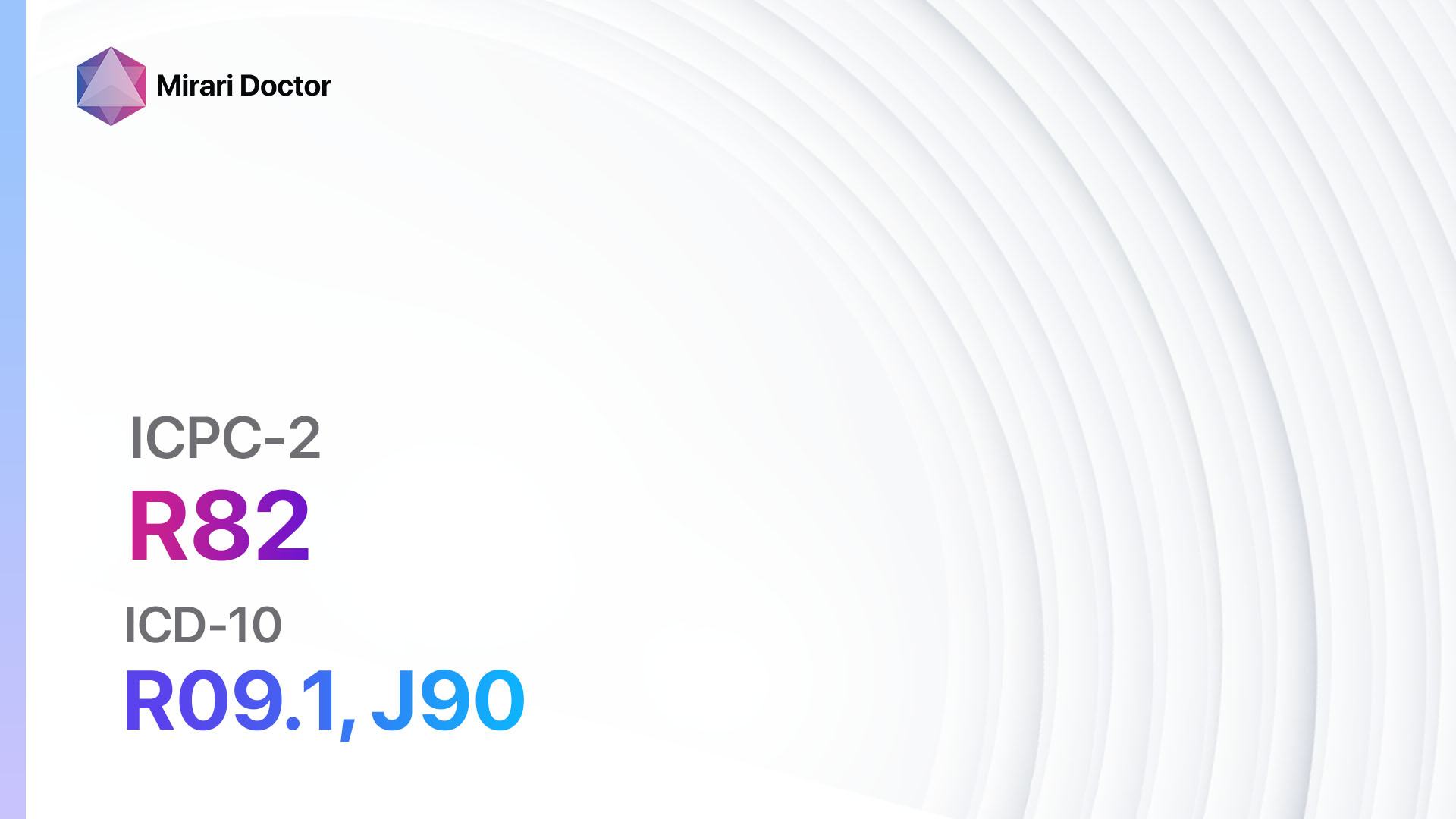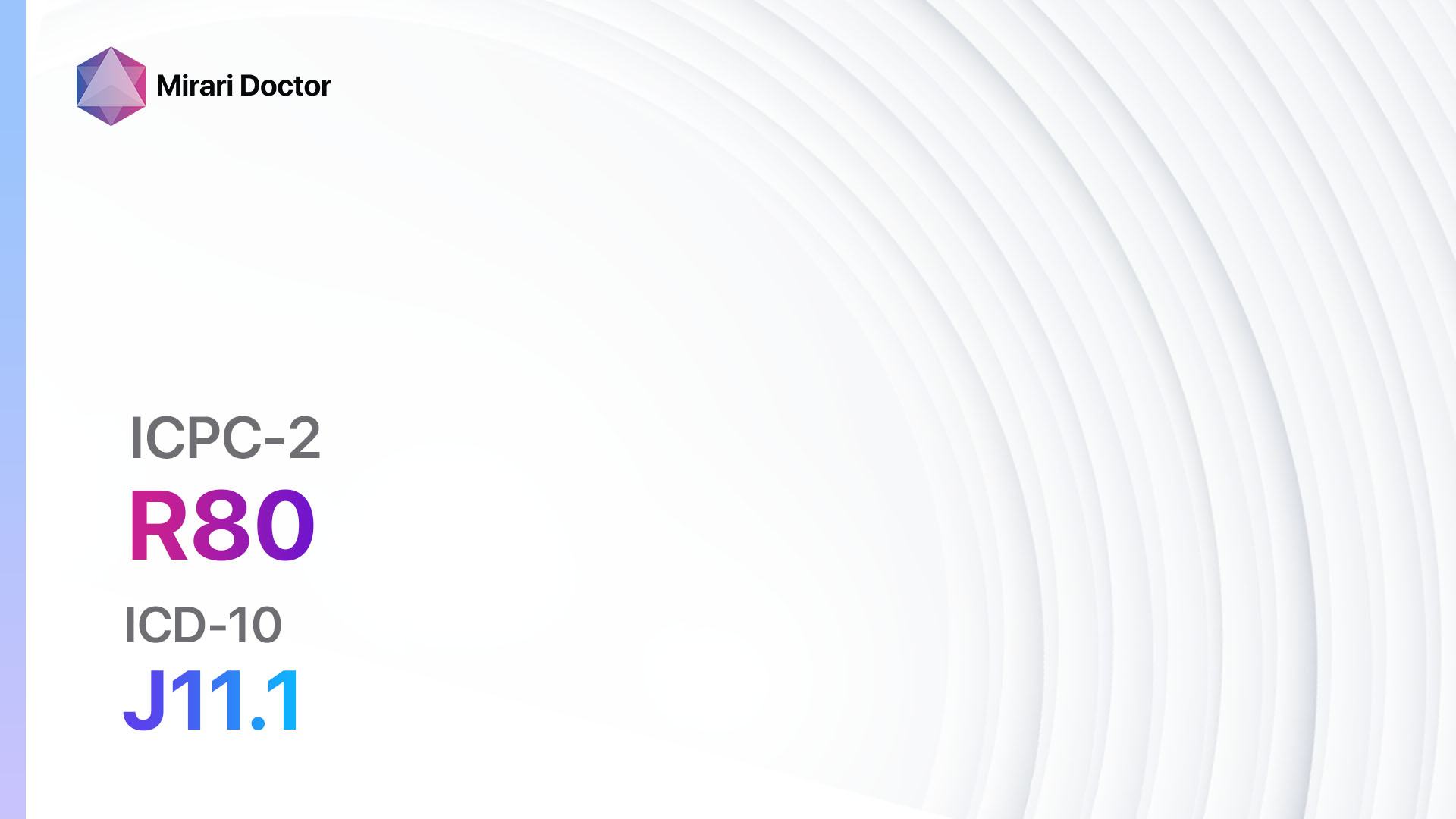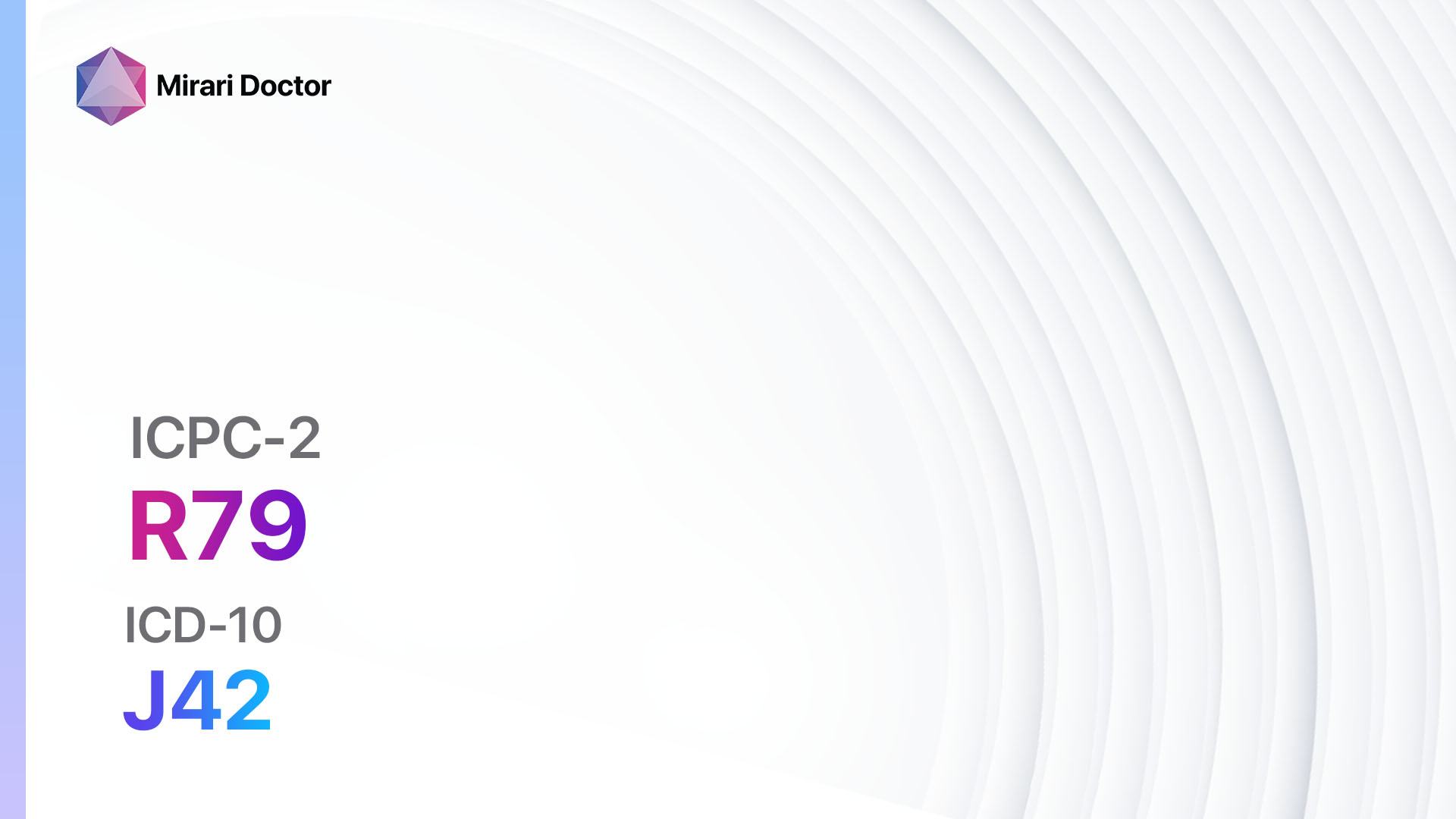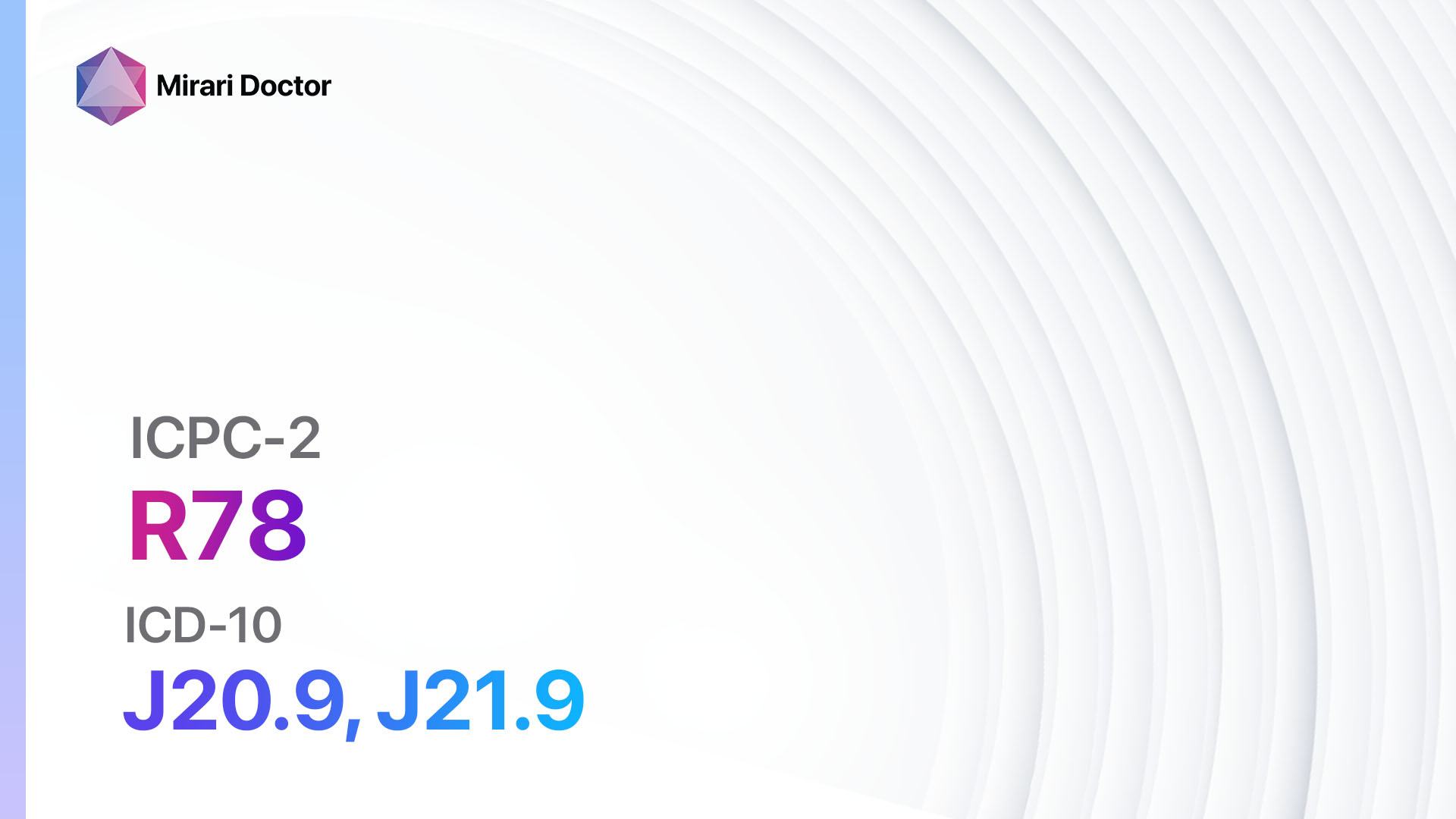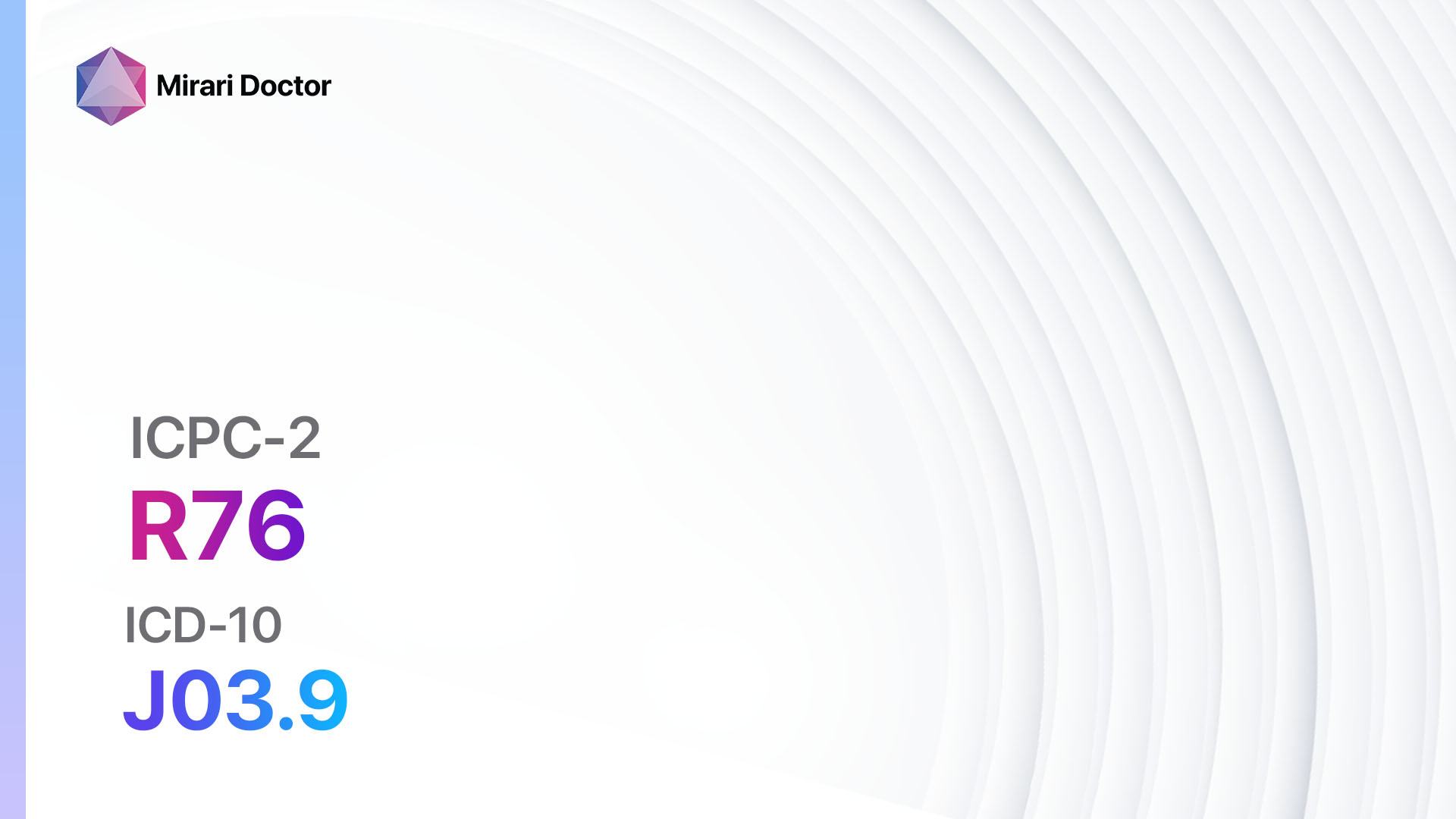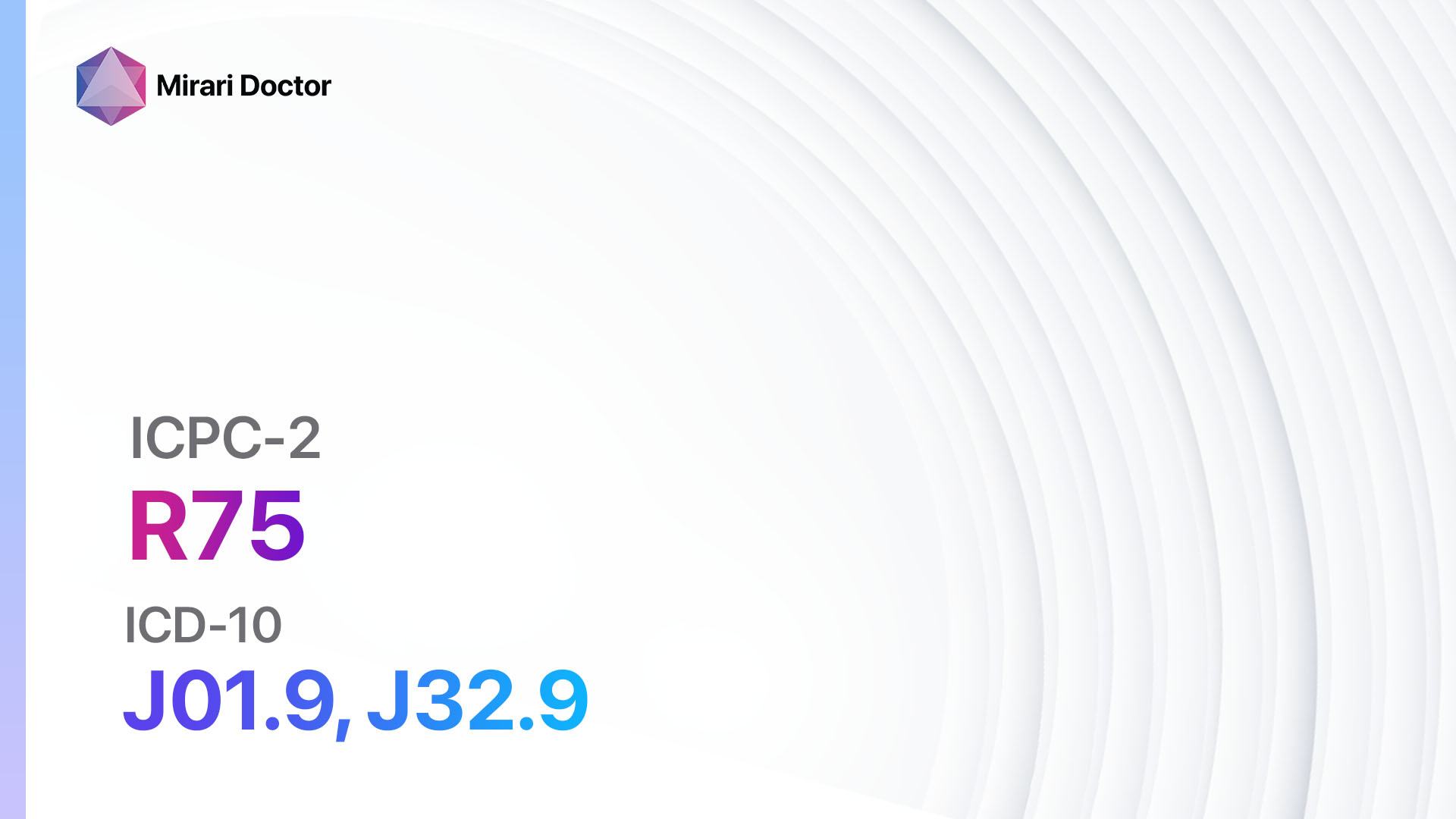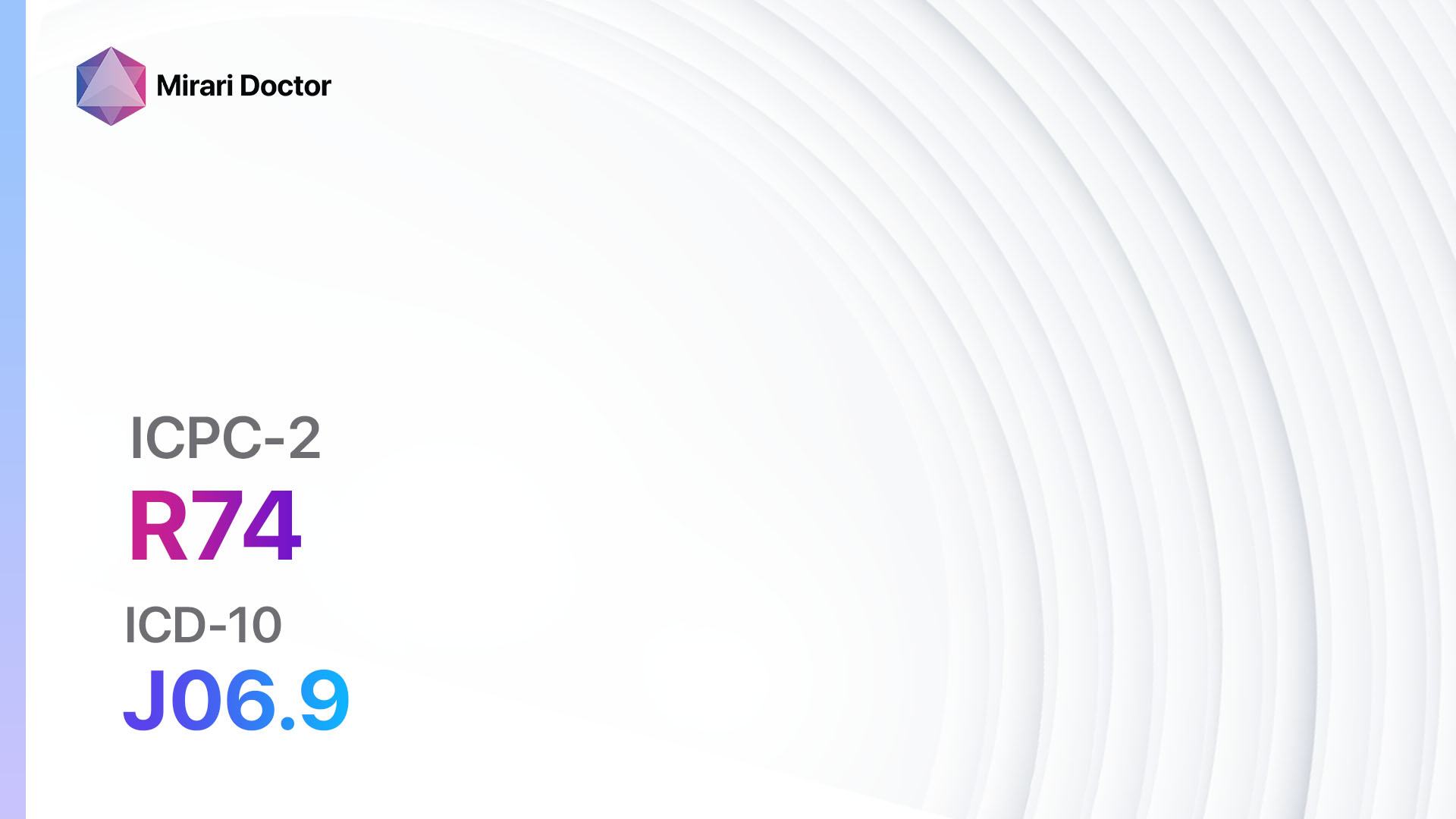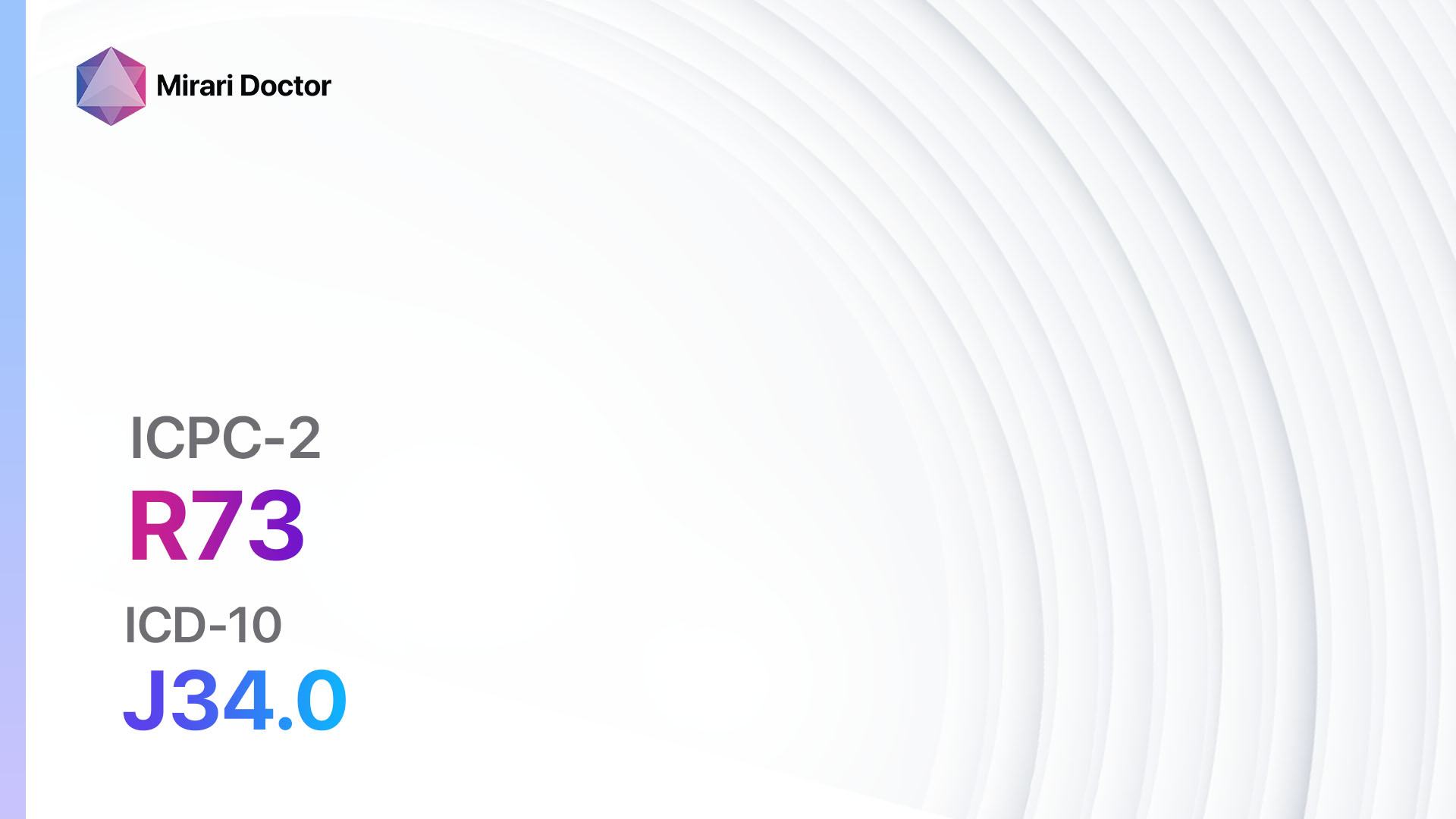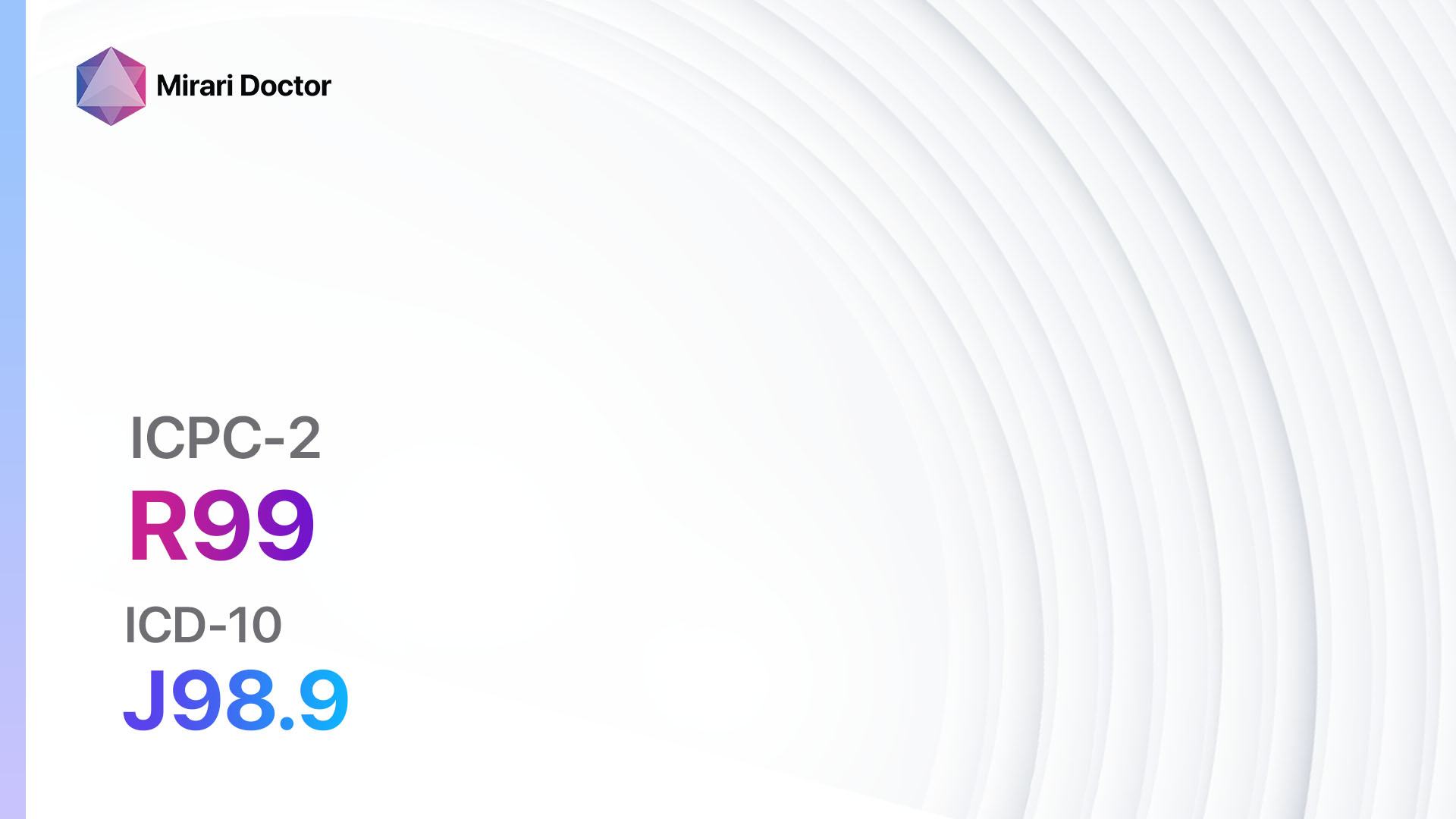
Introduction
Respiratory disease other (ICPC-2: R99) refers to a category of respiratory conditions that do not fall under specific diagnoses. These conditions may present with various symptoms and causes, making diagnosis and treatment challenging.[1]The aim of this guide is to provide healthcare professionals with a comprehensive approach to diagnosing and managing respiratory disease other.
Codes
- ICPC-2 Code: R99 Respiratory disease other
- ICD-10 Code: J98.9 Respiratory disorder, unspecified[2]
Symptoms
- Cough: Persistent cough that may be dry or productive.
- Shortness of breath: Difficulty breathing or feeling breathless.
- Chest pain: Discomfort or pain in the chest area.
- Wheezing: High-pitched whistling sound during breathing.
- Fatigue: Feeling tired or lacking energy.
- Fever: Elevated body temperature.
- Sputum production: Excessive mucus or phlegm production.
- Hemoptysis: Coughing up blood.
- Respiratory distress: Rapid breathing, increased work of breathing, or cyanosis.[3]
Causes
- Infections: Viral, bacterial, or fungal infections can cause respiratory symptoms.
- Allergies: Exposure to allergens can trigger respiratory symptoms.
- Environmental factors: Exposure to pollutants, chemicals, or irritants can lead to respiratory issues.
- Smoking: Tobacco smoke can damage the respiratory system and cause various respiratory symptoms.
- Chronic conditions: Underlying chronic conditions such as asthma, chronic obstructive pulmonary disease (COPD), or interstitial lung disease can contribute to respiratory symptoms.
- Autoimmune diseases: Certain autoimmune diseases can affect the respiratory system and lead to respiratory symptoms.[4]
Diagnostic Steps
Medical History
- Gather information about the patient’s symptoms, including their duration, severity, and any triggering factors.
- Assess the patient’s medical history, including any pre-existing respiratory conditions, allergies, or chronic diseases.
- Inquire about the patient’s smoking history and exposure to environmental factors or occupational hazards.
- Identify any relevant family history of respiratory diseases or conditions.[5]
Physical Examination
- Perform a comprehensive physical examination, including auscultation of the lungs, assessment of respiratory rate and effort, and examination of the chest for any abnormalities.
- Look for signs of respiratory distress, such as increased work of breathing, use of accessory muscles, or cyanosis.
- Check for any wheezing, crackles, or decreased breath sounds on auscultation of the lungs.
- Assess the patient’s vital signs, including temperature, heart rate, and oxygen saturation.[6]
Laboratory Tests
- Complete blood count (CBC): To assess for any signs of infection or inflammation.
- C-reactive protein (CRP): Elevated levels may indicate inflammation.
- Pulmonary function tests (PFTs): Measure lung function and assess for any obstructive or restrictive patterns.
- Arterial blood gas (ABG) analysis: Evaluates oxygen and carbon dioxide levels in the blood.
- Allergy testing: Identifies specific allergens that may be triggering respiratory symptoms.
- Sputum culture and sensitivity: Helps identify the presence of bacteria or fungi in the respiratory tract.
- Serological tests: May be performed to detect specific antibodies or viral antigens.[7]
Diagnostic Imaging
- Chest X-ray: Provides a basic evaluation of the lungs and can identify abnormalities such as infiltrates, masses, or pneumothorax.
- Computed tomography (CT) scan: Offers a more detailed assessment of the lungs and surrounding structures, useful for detecting tumors, infections, or interstitial lung disease.
- Magnetic resonance imaging (MRI): May be used in specific cases to evaluate lung or mediastinal abnormalities.
- Positron emission tomography (PET) scan: Can help identify areas of increased metabolic activity, useful for detecting lung cancer or metastases.
- Ultrasound: May be used to evaluate pleural effusions or guide procedures such as thoracentesis or biopsy.[8]
Other Tests
- Bronchoscopy: Invasive procedure that allows direct visualization of the airways and collection of samples for further evaluation.
- Lung biopsy: Involves obtaining a tissue sample from the lungs for pathological examination.
- Sleep study: Evaluates for sleep-related respiratory disorders such as sleep apnea.
- Exercise testing: Assesses lung function during physical exertion.
- Genetic testing: May be indicated in certain cases to identify specific genetic mutations associated with respiratory diseases.[9]
Follow-up and Patient Education
- Schedule follow-up appointments to monitor the patient’s progress and response to treatment.
- Provide education on the importance of adherence to prescribed medications and lifestyle modifications.
- Discuss the potential complications and long-term prognosis of respiratory disease other.
- Encourage the patient to seek medical attention if symptoms worsen or new symptoms develop.[10]
Possible Interventions
Traditional Interventions
Medications:
Top 5 drugs for Respiratory disease other:
- Bronchodilators (e.g., Albuterol, Salbutamol):
- Cost: Generic versions can range from $10 to $50 per inhaler.
- Contraindications: Hypersensitivity to the medication.
- Side effects: Tremors, increased heart rate, headache.
- Severe side effects: Chest pain, irregular heart rhythm.
- Drug interactions: Beta-blockers, diuretics.
- Warning: Overuse may lead to decreased effectiveness.
- Corticosteroids (e.g., Prednisone, Fluticasone):
- Cost: Generic versions can range from $10 to $50 per month.
- Contraindications: Active infections, systemic fungal infections.
- Side effects: Increased appetite, weight gain, mood changes.
- Severe side effects: Adrenal suppression, osteoporosis.
- Drug interactions: NSAIDs, anticoagulants.
- Warning: Long-term use may require monitoring for side effects.
- Antibiotics (e.g., Amoxicillin, Azithromycin):
- Cost: Generic versions can range from $5 to $50 per course.
- Contraindications: Allergy to the specific antibiotic.
- Side effects: Upset stomach, diarrhea, rash.
- Severe side effects: Severe allergic reactions, Clostridium difficile infection.
- Drug interactions: Warfarin, oral contraceptives.
- Warning: Antibiotics should be used judiciously to prevent antibiotic resistance.
- Antihistamines (e.g., Loratadine, Cetirizine):
- Cost: Generic versions can range from $5 to $20 per month.
- Contraindications: Hypersensitivity to the medication.
- Side effects: Drowsiness, dry mouth, blurred vision.
- Severe side effects: Severe allergic reactions, difficulty urinating.
- Drug interactions: Sedatives, alcohol.
- Warning: Some antihistamines may cause drowsiness.
- Mucolytics (e.g., Acetylcysteine, Guaifenesin):
- Cost: Generic versions can range from $5 to $20 per month.
- Contraindications: Hypersensitivity to the medication.
- Side effects: Nausea, vomiting, runny nose.
- Severe side effects: Severe allergic reactions, bronchospasm.
- Drug interactions: Nitroglycerin, antitussives.
- Warning: Mucolytics may cause airway obstruction in some cases.
Alternative Drugs:
- Leukotriene modifiers (e.g., Montelukast): Useful for patients with allergic respiratory symptoms.
- Antiviral medications (e.g., Oseltamivir): May be prescribed for respiratory infections caused by specific viruses.
- Immunosuppressants (e.g., Methotrexate): Used in certain autoimmune respiratory diseases.
- Antifungal medications (e.g., Fluconazole): Prescribed for fungal respiratory infections.
- Biologic therapies (e.g., Omalizumab): Used in specific cases of severe allergic respiratory diseases.
Surgical Procedures:
- Lung biopsy: Invasive procedure to obtain a tissue sample for pathological examination.
- Thoracentesis: Removal of fluid or air from the pleural space using a needle.
- Pleurodesis: Procedure to create adhesions between the layers of the pleura to prevent recurrent pleural effusions.
- Lung volume reduction surgery: Surgical removal of damaged lung tissue to improve lung function in certain cases of respiratory disease.
- Lung transplantation: Reserved for severe cases of respiratory disease with irreversible lung damage.
Alternative Interventions
- Acupuncture: May help alleviate respiratory symptoms and improve overall well-being. Cost: $60-$120 per session.
- Herbal supplements: Certain herbs, such as licorice root or eucalyptus, may have potential benefits for respiratory health. Cost: Varies depending on the specific supplement.
- Breathing exercises: Techniques such as pursed-lip breathing or diaphragmatic breathing can help improve lung function and reduce respiratory symptoms. Cost: Free.
- Salt therapy: Inhaling salt-infused air in a controlled environment may help reduce inflammation and improve respiratory symptoms. Cost: $20-$50 per session.
- Steam inhalation: Inhaling steam from hot water or essential oils can help relieve congestion and soothe respiratory passages. Cost: Free.
Lifestyle Interventions
- Smoking cessation: Encourage patients to quit smoking to improve respiratory health and reduce symptoms. Cost: Varies depending on the chosen smoking cessation method.
- Regular exercise: Engaging in physical activity can improve lung function and overall respiratory health. Cost: Varies depending on the chosen exercise program or gym membership.
- Healthy diet: Encourage a balanced diet rich in fruits, vegetables, and lean proteins to support respiratory health. Cost: Varies depending on individual food choices.
- Environmental modifications: Advise patients to avoid exposure to pollutants, allergens, or irritants that may trigger respiratory symptoms. Cost: Varies depending on the necessary modifications (e.g., air purifiers, allergen-proof bedding).
- Stress management: Stress can worsen respiratory symptoms, so encourage patients to practice stress-reducing techniques such as meditation or yoga. Cost: Varies depending on the chosen stress management method.
It is important to note that the cost ranges provided are approximate and may vary depending on the location and availability of the interventions.
Mirari Cold Plasma Alternative Intervention
Understanding Mirari Cold Plasma
- Safe and Non-Invasive Treatment:Mirari Cold Plasma is a safe and non-invasive treatment option for various skin conditions. It does not require incisions, minimizing the risk of scarring, bleeding, or tissue damage.
- Efficient Extraction of Foreign Bodies:Mirari Cold Plasma facilitates the removal of foreign bodies from the skin by degrading and dissociating organic matter, allowing easier access and extraction.
- Pain Reduction and Comfort:Mirari Cold Plasma has a local analgesic effect, providing pain relief during the treatment, making it more comfortable for the patient.
- Reduced Risk of Infection:Mirari Cold Plasma has antimicrobial properties, effectively killing bacteria and reducing the risk of infection.
- Accelerated Healing and Minimal Scarring: Mirari Cold Plasma stimulates wound healing and tissue regeneration, reducing healing time and minimizing the formation of scars.
Mirari Cold Plasma Prescription
Video instructions for using Mirari Cold Plasma Device – R99 Respiratory disease other (ICD-10:J98.9)
| Mild | Moderate | Severe |
| Mode setting: 1 (Infection) Location: 5 (Lungs) Morning: 15 minutes, Evening: 15 minutes | Mode setting: 1 (Infection) Location: 5 (Lungs) Morning: 30 minutes, Lunch: 30 minutes, Evening: 30 minutes | Mode setting: 1 (Infection) Location: 5 (Lungs) Morning: 30 minutes, Lunch: 30 minutes, Evening: 30 minutes |
| Mode setting: 2 (Wound) Location: 5 (Lungs) Morning: 15 minutes, Evening: 15 minutes | Mode setting: 2 (Wound) Location: 5 (Lungs) Morning: 30 minutes, Lunch: 30 minutes, Evening: 30 minutes | Mode setting: 2 (Wound) Location: 5 (Lungs) Morning: 30 minutes, Lunch: 30 minutes, Evening: 30 minutes |
| Mode setting: 3 (Antiviral Therapy) Location: 5 (Lungs) Morning: 15 minutes, Evening: 15 minutes | Mode setting: 3 (Antiviral Therapy) Location: 5 (Lungs) Morning: 30 minutes, Lunch: 30 minutes, Evening: 30 minutes | Mode setting: 3 (Antiviral Therapy) Location: 5 (Lungs) Morning: 30 minutes, Lunch: 30 minutes, Evening: 30 minutes |
| Mode setting:7 (Immunotherapy) Location:4 (Heart, Bile & Pancreas) Morning: 15 minutes, Evening: 15 minutes | Mode setting:7 (Immunotherapy) Location:4 (Heart, Bile & Pancreas) Morning: 30 minutes, Lunch: 30 minutes, Evening: 30 minutes | Mode setting:7 (Immunotherapy) Location:4 (Heart, Bile & Pancreas) Morning: 30 minutes, Lunch: 30 minutes, Evening: 30 minutes |
| Total Morning:60minutesapprox.$10USD, Evening:60minutesapprox.$10USD | Total Morning:120minutesapprox.$20USD, Lunch:120minutesapprox. $20 USD, Evening:120minutesapprox. $20 USD, | Total Morning:120minutesapprox.$20USD, Lunch:120minutesapprox. $20 USD, Evening:120minutesapprox. $20 USD, |
| Usualtreatmentfor7-60daysapprox.$140USD–$1200USD | Usualtreatmentfor6-8weeksapprox.$2,520USD–$3,360USD | Usualtreatmentfor3-6monthsapprox.$5,400USD–$10,800USD |
 |
|
Use the Mirari Cold Plasma device to treat Respiratory disease other effectively.
WARNING: MIRARI COLD PLASMA IS DESIGNED FOR THE HUMAN BODY WITHOUT ANY ARTIFICIAL OR THIRD PARTY PRODUCTS. USE OF OTHER PRODUCTS IN COMBINATION WITH MIRARI COLD PLASMA MAY CAUSE UNPREDICTABLE EFFECTS, HARM OR INJURY. PLEASE CONSULT A MEDICAL PROFESSIONAL BEFORE COMBINING ANY OTHER PRODUCTS WITH USE OF MIRARI.
Step 1: Cleanse the Skin
- Start by cleaning the affected area of the skin with a gentle cleanser or mild soap and water. Gently pat the area dry with a clean towel.
Step 2: Prepare the Mirari Cold Plasma device
- Ensure that the Mirari Cold Plasma device is fully charged or has fresh batteries as per the manufacturer’s instructions. Make sure the device is clean and in good working condition.
- Switch on the Mirari device using the power button or by following the specific instructions provided with the device.
- Some Mirari devices may have adjustable settings for intensity or treatment duration. Follow the manufacturer’s instructions to select the appropriate settings based on your needs and the recommended guidelines.
Step 3: Apply the Device
- Place the Mirari device in direct contact with the affected area of the skin. Gently glide or hold the device over the skin surface, ensuring even coverage of the area experiencing.
- Slowly move the Mirari device in a circular motion or follow a specific pattern as indicated in the user manual. This helps ensure thorough treatment coverage.
Step 4: Monitor and Assess:
- Keep track of your progress and evaluate the effectiveness of the Mirari device in managing your Respiratory disease other. If you have any concerns or notice any adverse reactions, consult with your health care professional.
Note
This guide is for informational purposes only and should not replace the advice of a medical professional. Always consult with your healthcare provider or a qualified medical professional for personal advice, diagnosis, or treatment. Do not solely rely on the information presented here for decisions about your health. Use of this information is at your own risk. The authors of this guide, nor any associated entities or platforms, are not responsible for any potential adverse effects or outcomes based on the content.
Mirari Cold Plasma System Disclaimer
- Purpose: The Mirari Cold Plasma System is a Class 2 medical device designed for use by trained healthcare professionals. It is registered for use in Thailand and Vietnam. It is not intended for use outside of these locations.
- Informational Use: The content and information provided with the device are for educational and informational purposes only. They are not a substitute for professional medical advice or care.
- Variable Outcomes: While the device is approved for specific uses, individual outcomes can differ. We do not assert or guarantee specific medical outcomes.
- Consultation: Prior to utilizing the device or making decisions based on its content, it is essential to consult with a Certified Mirari Tele-Therapist and your medical healthcare provider regarding specific protocols.
- Liability: By using this device, users are acknowledging and accepting all potential risks. Neither the manufacturer nor the distributor will be held accountable for any adverse reactions, injuries, or damages stemming from its use.
- Geographical Availability: This device has received approval for designated purposes by the Thai and Vietnam FDA. As of now, outside of Thailand and Vietnam, the Mirari Cold Plasma System is not available for purchase or use.
References
- World Health Organization. (2021). International Classification of Primary Care, Second edition (ICPC-2). Retrieved from//www.who.int/standards/classifications/other-classifications/international-classification-of-primary-care
- World Health Organization. (2019). International Statistical Classification of Diseases and Related Health Problems, 10th Revision (ICD-10). Retrieved from//icd.who.int/browse10/2019/en
- Leach, R. M. (2008). Symptoms and signs of respiratory disease. Medicine, 36(3), 119-125.
- Bousquet, J., Khaltaev, N., Cruz, A. A., et al. (2008). Allergic Rhinitis and its Impact on Asthma (ARIA) 2008 update. Allergy, 63(s86), 8-160.
- Rivera, M. P., Mehta, A. C., & Wahidi, M. M. (2013). Establishing the diagnosis of lung cancer: Diagnosis and management of lung cancer, 3rd ed: American College of Chest Physicians evidence-based clinical practice guidelines. Chest, 143(5), e142S-e165S.
- Spiro, S. G., Gould, M. K., & Colice, G. L. (2007). Initial evaluation of the patient with lung cancer: symptoms, signs, laboratory tests, and paraneoplastic syndromes: ACCP evidenced-based clinical practice guidelines. Chest, 132(3), 149S-160S.
- Metlay, J. P., Waterer, G. W., Long, A. C., et al. (2019). Diagnosis and Treatment of Adults with Community-acquired Pneumonia. An Official Clinical Practice Guideline of the American Thoracic Society and Infectious Diseases Society of America. American Journal of Respiratory and Critical Care Medicine, 200(7), e45-e67.
- Nair, V. S., Sundaram, V., Desai, M., & Gould, M. K. (2018). Accuracy of models to identify lung nodule cancer risk in the National Lung Screening Trial. American Journal of Respiratory and Critical Care Medicine, 197(9), 1220-1223.
- Lindeman, N. I., Cagle, P. T., Aisner, D. L., et al. (2018). Updated Molecular Testing Guideline for the Selection of Lung Cancer Patients for Treatment With Targeted Tyrosine Kinase Inhibitors: Guideline From the College of American Pathologists, the International Association for the Study of Lung Cancer, and the Association for Molecular Pathology. Journal of Molecular Diagnostics, 20(2), 129-159.
- Postmus, P. E., Kerr, K. M., Oudkerk, M., et al. (2017). Early and locally advanced non-small-cell lung cancer (NSCLC): ESMO Clinical Practice Guidelines for diagnosis, treatment and follow-up. Annals of Oncology, 28(suppl_4), iv1-iv21.
Related articles
Made in USA


